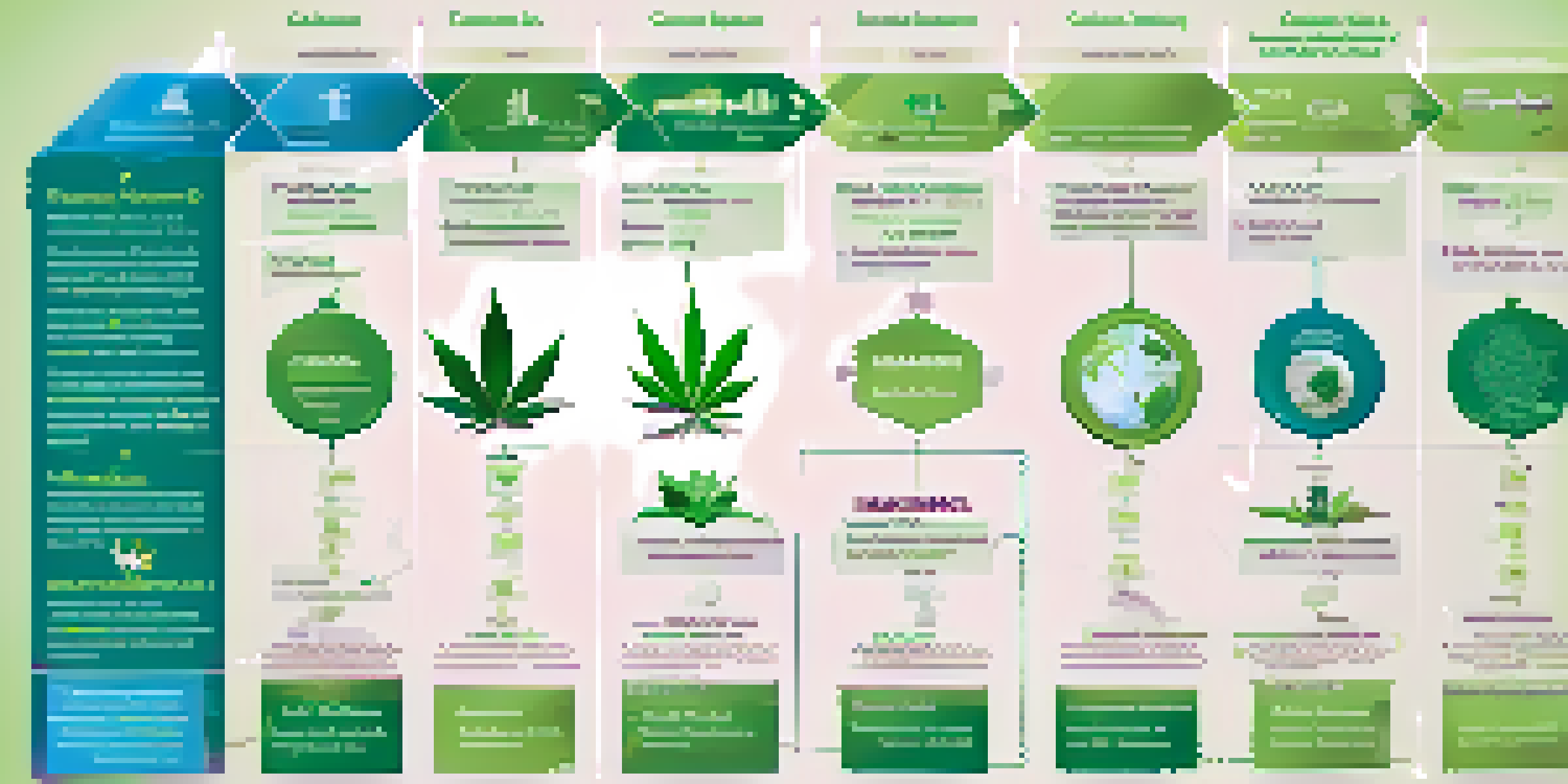Marijuana Advertising Regulations Varying by Region

Understanding Marijuana Advertising Regulations
Marijuana advertising regulations can be complex and vary significantly by region. In some places, cannabis is fully legal, while in others, it remains strictly prohibited. These differences influence how companies can market their products, making it essential for businesses to stay informed about local laws.
As the industry matures, we can expect to see more standardized practices that prioritize public health and safety.
For instance, in states like Colorado and California, cannabis advertising is robust, with billboards and digital ads common. On the flip side, in countries where cannabis is illegal, any form of advertising can lead to severe penalties. Understanding the legal landscape is crucial for any cannabis business looking to thrive.
Moreover, even within regions where marijuana is legal, specific rules may dictate how and where companies can advertise. This includes restrictions on targeting minors or promoting excessive consumption, which can vary not just by country but also by state or province.
Regional Differences in Advertising Restrictions
In the United States, each state has its own set of rules governing marijuana advertising. For example, while California allows ads on television and radio, New York has stricter guidelines that limit advertising to specific platforms. This patchwork of regulations can be confusing for businesses trying to operate across state lines.

In contrast, countries like Canada have a more unified approach. The Cannabis Act provides clear guidelines on advertising, such as prohibiting endorsements by celebrities or influencers, which aims to protect public health. Such regulations help ensure that advertising remains responsible and does not glamorize cannabis use.
Navigating Complex Regulations
Marijuana advertising regulations vary significantly by region, requiring businesses to stay informed to avoid legal pitfalls.
Internationally, places like Uruguay have legalized cannabis and established their own advertising frameworks. These regulations reflect cultural attitudes towards cannabis and can serve as a model for other countries considering legalization.
The Impact of Legalization on Advertising Practices
As more regions move towards legalization, advertising practices evolve alongside the changing regulations. Businesses must adapt their marketing strategies to comply with new laws while still reaching their target audience. This shift often requires creative approaches to advertising that respect legal boundaries.
Education plays a pivotal role in the cannabis advertising landscape.
For instance, in legalized markets, companies may focus on educational content rather than direct promotion. This means providing information about health benefits, responsible use, and product quality, which resonates well with consumers looking for trustworthy brands. Such strategies can help foster a positive public perception of cannabis.
Additionally, the rise of digital marketing has opened new avenues for cannabis companies. Social media platforms have their own rules regarding cannabis ads, and businesses must navigate these challenges to effectively engage with their audience.
Challenges in Navigating Advertising Regulations
One major challenge businesses face in the cannabis industry is the constantly changing landscape of advertising regulations. As lawmakers adapt to the evolving perceptions of cannabis, companies must stay vigilant to avoid unintentional violations. This requires ongoing education and flexibility in marketing tactics.
Moreover, the lack of standardization across regions can lead to confusion for both businesses and consumers. For example, a campaign that is perfectly legal in one state could be completely outlawed in another. This unpredictability makes it crucial for companies to have local legal counsel or compliance teams.
Emphasis on Education
Companies that prioritize educating their audience about cannabis can build trust and comply with evolving advertising laws.
Lastly, the stigma surrounding cannabis can complicate advertising efforts. Even in legalized areas, some media outlets may refuse cannabis ads, limiting options for companies and forcing them to think outside the box to reach their audience.
Future Trends in Marijuana Advertising Regulations
Looking ahead, the trend towards more comprehensive regulations in marijuana advertising seems likely. As the industry matures, we can expect to see more standardized practices that prioritize public health and safety. This might include stricter age verification processes and clearer labeling requirements.
Additionally, as research on cannabis continues to grow, we may see a push for advertising that emphasizes scientific evidence and responsible use. This shift could help demystify cannabis for the public and promote healthier consumption habits.
Furthermore, the rise of social media influencers in the cannabis space could lead to new regulations. Authorities might implement guidelines to ensure that influencer marketing aligns with existing laws, helping to create a safer and more transparent advertising environment.
The Role of Education in Cannabis Advertising
Education plays a pivotal role in the cannabis advertising landscape. As regulations evolve, companies that prioritize educating their audience about cannabis will likely find greater success. This involves not just promoting products but also sharing knowledge about responsible usage and potential health benefits.
For example, many cannabis brands create informative blog posts, videos, or webinars that help demystify their products. By positioning themselves as trusted sources of information, these companies can build a loyal customer base while adhering to advertising regulations.
Future Trends in Advertising
As the cannabis industry matures, we can expect more standardized regulations that prioritize public health and responsible marketing.
Moreover, educational outreach can help reduce stigma surrounding cannabis. As more people become informed about its benefits and risks, they may be more receptive to advertising and less likely to view it negatively.
Conclusion: Navigating the Future of Marijuana Advertising
In conclusion, the landscape of marijuana advertising regulations is complex and constantly shifting. Businesses must remain adaptable, informed, and creative to navigate these challenges successfully. By understanding regional differences and embracing education in their marketing practices, companies can thrive in this dynamic environment.
As more regions consider legalization, the conversation around cannabis advertising will continue to evolve. Stakeholders must work together to ensure that regulations are both fair and effective, fostering a responsible cannabis culture.

Ultimately, the future of marijuana advertising will depend on balancing effective marketing with public health considerations. As the industry grows, so too will the opportunities for responsible and innovative advertising strategies.